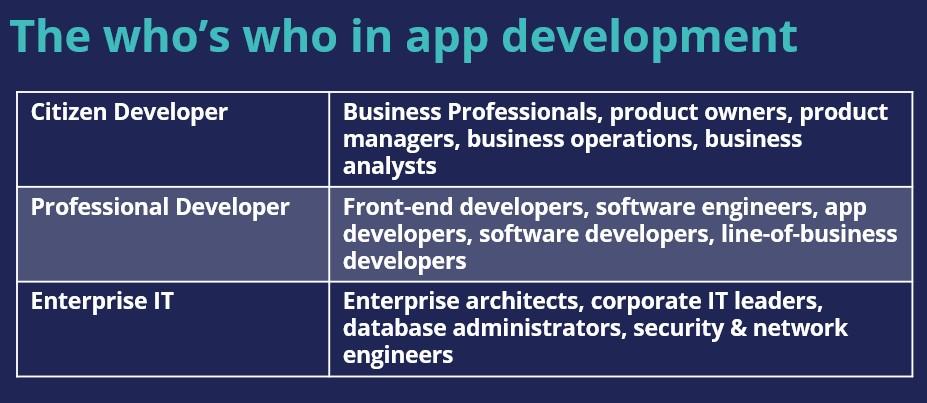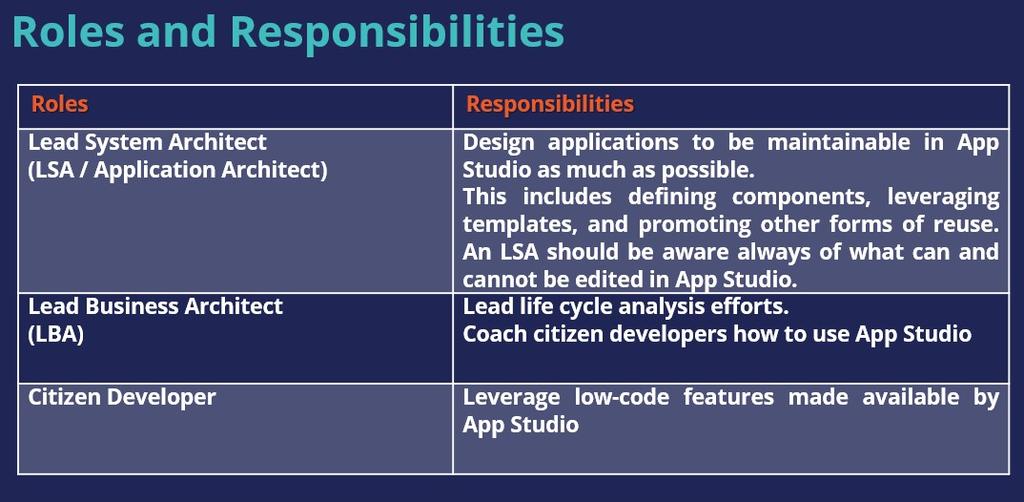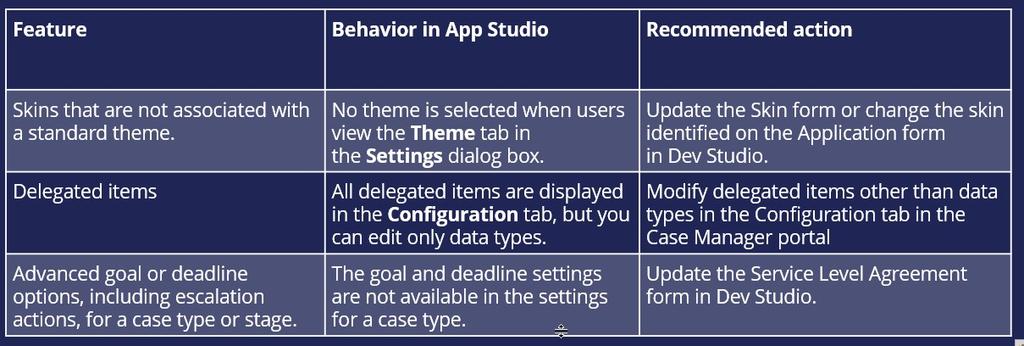
App Studio development
Citizen development
Business units are increasingly controlling their application development efforts, and citizen developers play a crucial role in advancing this effort. Citizen developers are business professionals who are empowered to build and design real enterprise applications and fast track go-to-market solutions. Application leaders — lead system architects (LSAs) — need to help define, guide, and optimize citizen development to maximize mutual benefits for business and IT. Enterprise Low-Code App Studio can bring business and IT together in real-time, using visual models and an agile methodology to build apps rapidly.
Citizen developers can confidently build on features that LSAs make available through reusability patterns.
App Studio includes contextual help and tours for self-learning, enabling business experts and citizen developers to directly capture their objectives and quickly configure applications in Pega Platform™.
Roles and responsibilities
Staff members certified in Pega act as coaches for teams of business experts and other citizen developers to facilitate application development.
App Studio supports real-time UI with predefined design templates. Any person involved in a business process can contribute to application planning and developing the approach that helps achieve the best effects while providing IT solutions for business.
Lead system architect responsibilities
Some of the more important lead system architect responsibilities required to support citizen development contributions using App Studio are:
- Using App Studio and defining the skeleton data objects needed by an application
- Using Dev studio to revise directed inheritance
- Ensuring quality and extensibility of the data models
- Enabling branch development so that citizen developers can use it
- Conducting branch reviews
- Creating user interface templates for selection in App Studio when configuring a view for a process step
- Decoupling the case layer from:
- Where the systems of record are
- What form the systems of record take
- How the systems of record persist the data
- Creating reusable components and marking as relevant records wherever possible so that they can be discovered in App Studio.
- Application design may require complex positioning of rules and placeholders for these rules in specific rulesets using Dev Studio which empowers the delivery team to pick up the relevant versions from App Studio where possible.
- Ensuring application is designed/implemented as per organization guardrails/best practices set by the Center of Excellence (COE)/LSA team
- Ensuring application rules are created in the correct layer and required/correct access is given to citizen developers/seasoned developers.
For example, the following diagram provides a simple example of how access can be granted based on role and layer.
Tasks that can be accomplished and App Studio benefits
Common tasks that can be accomplished with App Studio:
- Application packaging
- Application switching
- Add case type
- Case participant configuration
- Stage configuration and updates (such as stage validation, add optional process, optional actions, and alternate stages)
- Data type/data model viewing
- Data model definition by uploading a .csv or Excel file
- View configuration
- Application styling
- Personas and user creation
- Creating channel interfaces creation
- Persona-based portal configuration by using a simple, model-driven approach
- Page creation and modification (UI Pages) for use in menus to simplify navigation. With Pages, landing pages can be created immediately.
Benefits of App Studio
App Studio accelerates your project.
Building an application with App Studio in mind ensures guardrail compliance, transparency, and visibility.
App Studio can be leveraged for enablement, collaboration, and innovation.
Low-code application development techniques
Commit to leverage low-code application development (making use of App Studio):
Effective use of templates, engaging collaborators with different skills and roles saves time and increases work efficiency.
Create microjourneys for customer success
Help customers reach a successful resolution in their business processes by applying the Pega Express™ methodology while working on implementation projects through journeys and microjourneys™. When the focus is on one journey at a time, you reach results more rapidly.
Adopt feature-driven development
Develop capabilities in the context of a feature to maintain functional requirements and project status directly in your application. Associate features with elements of an application that needs to be developed.
Reuse build-on capabilities
Reuse the functionality that you inherit from built-on applications so that you can focus your development efforts on unique features and capabilities.
Design applications for reuse and extension
Save time and speed up your application development process by designing your applications for reuse and extension. When you create reusable elements, such as rules and classes, you can implement them again in future projects to make your work more efficient.
Engage and communicate with stakeholders and team members
Communication is a crucial part of developing applications. Pega Platform™ supports the uninterrupted exchange of information for development team members and users who process cases in your application. Enhance collaboration with shareable documents, spaces that gather professionally connected users, and messages that users can post in a Pulse gadget. Built-in social tools allow for agile and consistent cross-functional communication.
App Studio-compliant application
The App Studio Compliance User Interface landing page in Dev Studio can be leveraged to identify UI elements in an application that may present maintenance or upgrade issues. By analyzing the reports on this landing page, the developer can learn how to more efficiently render process-heavy components and save development time during future updates.
- In the header of Dev Studio, click Configure > Application > Quality > App Studio Compliance > User Interface.
- In the Built-on applications section, select one or more applications whose UI components to be reviewed.
- Click Apply.
- Review the report and follow the suggestions for updating UI components.
- Optional: To open a section that contains UI issues in a new tab, expand the relevant report header, and then click the section name.
Design-time behavior in App Studio
While creating an application in App Studio it is beneficial for developers to be aware of a few differences with Dev Studio. At design time, some features are disabled or have limited options when configured in Dev Studio and then switched to App Studio.
Note: The above is not an exhaustive list. For the complete list of limitations, see the latest App Studio help documentation.
This Topic is available in the following Modules:
If you are having problems with your training, please review the Pega Academy Support FAQs.
Want to help us improve this content?




